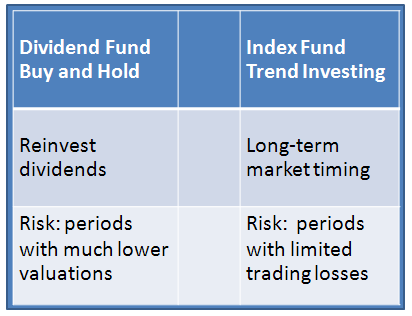Buy and Hold Dividend versus Trend Following Risks

When you apply a certain stock investing strategy, you implicitly choose to accept the risks that go with that strategy. Here we describe the specific risks for two well-know and often applied strategies.
- Buy and Hold a Dividend Fund
- Trend Following with Stock Market Index Funds
In summary you can say is that when you go for a “Buy and Hold a Dividend Fund’ strategy, you accept the possible value fluctuations of your investments while appreciating the dividend returns. While when you start trend following with index funds, you aim to capitalize on the long-term trend while accepting the risk of certain short-term trading losses when the market is moving more sideways for a longer period.
Let’s have a look at each strategy more in detail.

Buy and Hold Dividend Funds
When you chose a strategy to buy and hold dividend funds, you are not bothered by what the market price is at this moment for those funds. What you are primarily interested in is the dividend that you get from your investments.
To build your wealth and grow your savings, your main objective is to reinvest the dividends that you receive in more dividend funds. In this way you will have a long-term machine that automatically grows into more and more dividend paying funds.
With this strategy you accept the risks that there will be moments that if you would sell your funds, you will receive less money than that they were worth before. With this strategy you also accept that there will be periods that the amount of dividend that you receive will be less than in other periods since companies and funds can just not afford it at that moment.
The costs that you accept with this strategy are the opportunity costs. You do not make use of the potential opportunity that during certain periods your money could provide better absolute returns when invested in other assets than the chosen dividend funds.
But if your intention is to hold on to these funds for as long as you can foresee, and you are happy with the dividend returns, this could be a stock investing strategy for you.
Trend Following with Index Funds
When you chose a strategy of trend following stock market index funds, your intention is to buy at the beginning of a bull market and sell at the beginning of a bear market. The idea is to sell the index funds at a price that is higher than the level you bought them for a few years earlier. And after you sold your funds and the market went down for many months or years, you plan to buy these funds back at substantial lower costs.
By doing this way, you can outperform the market in the long run since you follow the market when there is a bull market and you have taken your savings out of the market when there is a bear market. But also this strategy has its risks.
Suppose that the market enters a long period without real bull or bear markets. For a few months, the market moves up. And then it moves down for a few months. Then it moves up again; and then down again.
The risk that you have with the trend following strategy is that in such a situation, you buy and sell a few times at the wrong moment. Your trend signals may indicate that the market is at the beginning of a bull market. But then shortly after you bought funds, the market starts falling for a few months.
Then the trend signals may start to point down and you sell your funds. A few months after that, the market may turn up again. In situations like this, you may carry the risk that you sell your funds for a lower price than that you have bought them.
Looking Back
Looking back at a period like this, it would have been better to just buy and hold. But that is when you look back. Before the market started to move sideways like this, you did not know that. At that moment it could have just well have turned into a market that showed clear long-term trends.
Afterwards it is always easy to see what strategy would have been the right one. Beforehand, there is no certainty. Which stock investing strategy is the one for you depends very much on the risks and potential rewards that you are seeking. In another post, we will see that you do not always have to choose between these two strategies and how you can apply both simultaneously.
To start looking forward, sign up now for our free stock investing email newsletter and get our latest analysis and ideas in your mailbox.
Next & Previous Blog Post
- ‹ previous
- 141 of 174
- next ›


